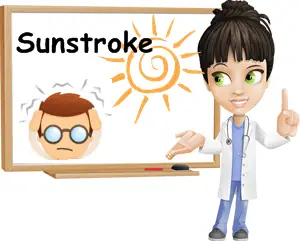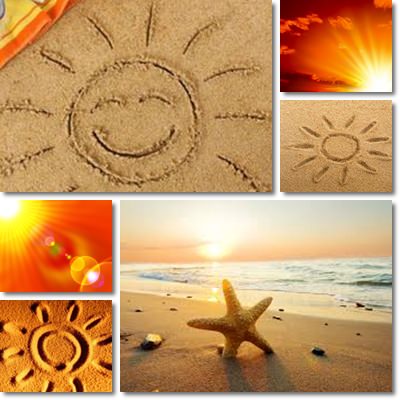Sun exposure can be a blessing to one’s health, but lying on the hot beach for too long under the scorching sun can lead to insolation, also known as heatstroke or sunstroke, exposing us to a series of unfortunate side effects and threatening our health and well-being. When controlled, sun exposure has several outstanding healing properties: it encourages the production of vitamin D, strengthens bones, relieves fibromyalgia pain and boosts energy.
Moreover, sufficient sun exposure improves mood and can even help treat skin problems and SAD (Seasonal Affective Disorder), to name a few of them. But no matter how good it may feel to take a nap on the beach or by the pool side, it is important that you take precautions to avoid over-exposure to direct sunlight. Specialists recommend that you avoid going outside between 11 a.m. and 16 p.m., wear a hat at all times, use sunscreen and keep hydrated.
Find out more about what is the best time for sun exposure.

Should you keep to these simple guidelines, you will most likely enjoy the beneficial properties of sun exposure:
- Disinfects the skin. Sun exposure can help disinfect your skin by getting rid of any bacteria that may live on it as well as some viruses.
- Stimulates vitamin D production. Vitamin D contributes to strong bones and teeth, helps maintain skin health, adjusts melatonin levels (a hormone that regulates sleep), stimulates immunity, boasts antibacterial properties and so on.
- Helps with skin disorders. Apparently, controlled sun exposure can help in the treatment of various skin problems such as psoriasis, atopic dermatitis and vitiligo as well as control symptoms. This is due to the antibacterial effect it has on the skin.
- Regulates melatonin levels. This basically means that moderate sun exposure can help regulate sleep (melatonin is responsible for sleep timing), treat common sleep disorders such as disturbed sleep or insomnia, increases antioxidant protection by scavenging free-radicals in the body and exhibits a strong immune-boosting activity.
- Improves SAD (Seasonal Affective Disorder) and depression. Sun exposure not only promotes relaxation and boosts energy levels in healthy individuals, but also helps improve conditions such as SAD or depression by positively altering mood.
- Other health benefits of sun exposure: helps with the management of arthritis pain and inflammation, is good for painful muscle spasms, bone pain as well as helps correct water retention by promoting sweating.
But what happens when you don’t keep to the guidelines for safe sunbathing? Well, you get sunstroke, also known as heatstroke or insolation and experience the side effects that come with the condition.

What is sunstroke and what happens when you get it?
Sunstroke is basically a matter of thermoregulation and is defined as an overheating of the body caused by overexposure to hot sunlight. It is caused by prolonged exposure to hot sunlight which results in a dangerous rise in body temperature which may end with collapse, convulsions and coma. Normally, our body absorbs the incoming sunlight and heat and adapts itself to the situation by triggering sweating as a form of thermoregulation.
But prolonged sunbathing in abnormally hot weather causes our sweat glands to stop working as they should, resulting in a state of hyperthermia (high body temperature) that is directly proportional to the duration and intensity of one’s sun exposure. You can recognize sunstroke (heatstroke, insolation) by the following signs and symptoms listed below.
Heatstroke signs and symptoms
- Skin problems such as high body temperature (manifest itself as fever, but is not the same), dry skin, blisters, burning sensation on the skin, rashes and redness are easily recognizable signs.
- Tearing of the eyes (lacrimation, watery eyes) and photophobia (physical sensitivity to light, often accompanied by discomfort or pain).
- Excessive thirst and heavy sweating. Dehydration, nausea, dizziness, headaches, fainting or collapse. High fever reaching 40 degrees Celsius.
- Convulsions and coma. This is a rare occurrence, but remains a possibility in the case of severe heatstroke.
What to do about it: prevention and solutions
Pay close attention to these signs and symptoms and, if you notice any of them after a sunbathing session, keep calm and seek medical help. Babies, children and elderly people are more susceptible to heatstroke than healthy adults so they represent a high-risk category. Here is what you need to do if you or a loved one gets sunstroke:
- Move to a well-shaded place and undress to allow the skin to breathe properly.
- Remove extra clothing such as shoes, socks, hats, scarfs, blazers and so on.
- Do not wrap yourself in cold towels to cool down.
- Do not use ice. Do not rub alcohol on the skin. This will make the body even more distressed by the temperature fluctuations up to the point that it simply crashes.
- Take a cool bath or shower, but not icy cold.
- If the person having suffered a heatstroke is unconscious, place cool, damp towels on the back of the neck, wrists, ankles, under the armpits, around the groin. Call the emergency telephone number.
- Restore circulation by massaging the body and keep calm. Panicking raises body temperature even more.
- Sip on a glass of water slowly, preferably with some salt in it (to help restore fluids and electrolyte balance).
- Lie down if you feel dizzy, nauseous or light-headed so you do not injure yourself should you faint.
- Avoid self-medicating, especially when it’s a severe case of sunstroke. Medication such as painkillers or paracetamol should be taken only after you have been examined by a doctor.
Overall, it is important to follow the guidelines for safe sunbathing listed above so as to help prevent sunstroke. Taking in sun can be a wonderfully pleasant experience with great health benefits, but excesses can do more harm than good. For this reason it is recommended to limit your sun exposure to safe hours, use sunscreen protection, wear hats and stay hydrated. If sunstroke does occur, then you know what to do.
